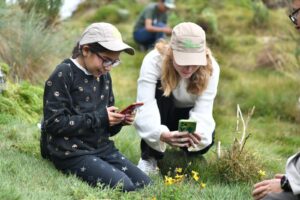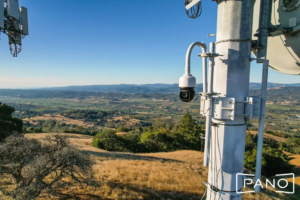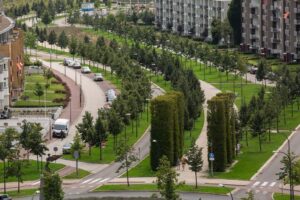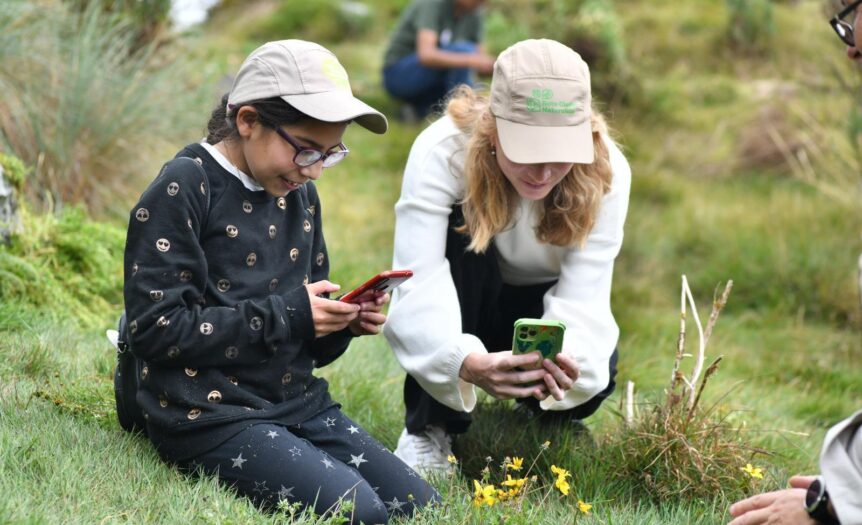Combining nature and technology might seem contradictory at first, but after years of exploration, I’m convinced it’s the key to managing urban greenery, boosting climate resilience, and strengthening the connection between city dwellers and the natural world.
As cities grow, natural spaces are increasingly threatened by urban development. Despite well-intentioned efforts like “million-tree campaigns,” greenery continues to decline globally, compromising air quality, water purification, and community well-being.
Nature, once a sanctuary for respite, is now tasked with mitigating urban challenges like the heat island effect, protecting cities from rising sea levels, inland flooding, and wildfires, while supporting biodiversity and enhancing human health. Yet, these vital green spaces are dwindling under the pressure of urban expansion, threatening the future of both people and ecosystems.
Recognizing the urgency, I’ve set out to discover how innovative technologies can proactively manage green spaces and nurture our bond with nature. In my book “The Nature of Our Cities: Harnessing the Power of the Natural World to Survive a Changing Planet,” I explore the work of “techno-ecologists” who are harnessing technology to foster thriving, nature-infused communities. I call their quest the ‘Internet of Nature’ (IoN).
Despite the hurdles, IoN pioneers show that technology can be a powerful ally in climate adaptation and nature conservation. I’m excited to share three examples from my book that illustrate how technology is enhancing nature in cities.
Unlocking Urban Biodiversity with the City Nature Challenge
 Alison Young of the California Academy of Sciences, along with Lila Higgins of the Natural History Museum of Los Angeles County, created the City Nature Challenge (CNC). Starting as a competition between San Francisco and Los Angeles in 2016, the CNC has grown into a global movement, inspiring urban dwellers worldwide to document local wildlife.
Alison Young of the California Academy of Sciences, along with Lila Higgins of the Natural History Museum of Los Angeles County, created the City Nature Challenge (CNC). Starting as a competition between San Francisco and Los Angeles in 2016, the CNC has grown into a global movement, inspiring urban dwellers worldwide to document local wildlife.
During a four-day annual “bio blitz”, participants use the iNaturalist app and website to log their observations, with a window for species identification and announcing winners. The CNC is accessible to all, thanks to iNaturalist’s automatic species identification and a supportive user community, including experts. It emphasizes collective achievement, fostering global biodiversity documentation and engagement, and unity.
As of 2024, over 700 cities have joined the CNC initiative worldwide. Remarkably, for three consecutive years, La Paz—the largest city in Bolivia—has emerged triumphant in the CNC, leading in total observations, species documented, and participation.
By involving citizens in scientific inquiry and data gathering, urban planners gain insights into urban green spaces’ ecological well-being, identifying biodiversity hotspots and guiding conservation efforts. The data aids in identifying areas of species diversity and those requiring habitat restoration, informing resource allocation for green infrastructure development and conservation projects. Across the globe, the CNC has catalyzed significant discoveries, shattering biodiversity records. In La Paz, researchers rediscovered a Bolivian snake previously thought extinct within the city limits, alongside a century-unseen blueberry bush. These findings deepen citizens’ connection with nature through interactive and educational outdoor activities.
AI Sentry Safeguarding Communities Amidst Escalating Wildfires
 In San Francisco, Sonia Kastner, founder of Pano AI, pioneers deep learning AI to detect, verify, and classify wildfires using surveillance cameras on towers. This IoN tool aims to identify fires early, with cameras on mountaintops utilizing advanced algorithms to detect smoke. Real-time data feeds enable remote reviewers to validate AI detections, refining the algorithm.
In San Francisco, Sonia Kastner, founder of Pano AI, pioneers deep learning AI to detect, verify, and classify wildfires using surveillance cameras on towers. This IoN tool aims to identify fires early, with cameras on mountaintops utilizing advanced algorithms to detect smoke. Real-time data feeds enable remote reviewers to validate AI detections, refining the algorithm.
The urgency arises from the increasing prevalence and destructiveness of wildfires in California, the western US, Canada, Europe, and beyond. Pano AI’s proactive approach holds promise for mitigating these disasters.
Sonia emphasizes the goal of accelerating the adoption of innovative firefighting techniques, like early heavy artillery use, such as aircraft and helicopters, to prevent fires from escalating. Within a year, Pano AI has demonstrated significant success.
During the Shedhorn Fire outbreak in September 2021 near Big Sky and West Yellowstone, Montana, Pano’s cameras detected the threat, enabling timely response measures that contained the fire to 74 acres. This early detection, before any 911 call, is crucial, particularly in remote areas where fires can smolder undetected for hours. Swift action saves lives and protects communities.
Furthermore, this approach is sustainable, reducing the need for daily helicopter flights and their carbon footprint. Sonia’s objective is to detect fires within the crucial first ten to fifteen minutes, ensuring swift action against wildfires.
AI-Driven Evolution of Proactive Tree Management
 In Maastricht in the Netherlands, we meet Tjeu Franssen, an arborist, who tends to newly planted trees along the “Groene Loper” park, facing challenges from dry, hot summers. To test soil moisture sensors’ effectiveness, we set up an experiment at two sites: the Groene Loper and another in eastern Maastricht. Three sensors were placed at the Groene Loper, while the second site had none. Throughout the summer, managers monitored and watered trees. Timely notifications from sensors prompted watering where needed.
In Maastricht in the Netherlands, we meet Tjeu Franssen, an arborist, who tends to newly planted trees along the “Groene Loper” park, facing challenges from dry, hot summers. To test soil moisture sensors’ effectiveness, we set up an experiment at two sites: the Groene Loper and another in eastern Maastricht. Three sensors were placed at the Groene Loper, while the second site had none. Throughout the summer, managers monitored and watered trees. Timely notifications from sensors prompted watering where needed.
By August’s end, we evaluated progress. Shockingly, almost a fifth of trees at the site without sensors had perished, while none were lost at the Groene Loper. Surprisingly, trees with sensors were significantly larger, some tripled in size.
These cutting-edge sensors have ensured an impressive 99% sapling survival rate in the face of increasingly dry and hot summers. However, it’s AI that promises to revolutionize this technology. By integrating weather data and historical watering records, these sensors can now facilitate predictive analytics. This means avoiding unnecessary trips, thereby saving time, money, and resources, and reducing carbon footprint, similar to the helicopters spared through Pano AI’s technology.
Nature First, Technology Second
At the heart of the book is a crucial question: How can we sustain nature-rich cities in the face of climate change, without compromising modern conveniences?
While technology plays a key role, the real driving force is the individuals—like Alison, Sonja, and Tjeu—who lead the IoN movement. Their passion and dedication are reshaping urban landscapes, fueled by the urgent need to bring nature back into cities.
To explore their groundbreaking work and that of others, dive into my book The Nature of Our Cities: Harnessing the Power of the Natural World to Survive a Changing Planet. Learn more here.























